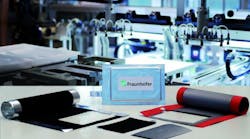LiS Batteries Promise Cheap Roll-to-roll Production for Electromobility
The following article was originally published in ee DesignNews Europe. It is reprinted here with permission.
The in-house project pushed the development of Lithium-sulphur batteries using new cathodes, electrolytes, and anodes that could attractively replace today’s Lithium-ion batteries in electromobility applications. Lithium-sulphur distinguishes itself with its very low material cost and high energy density up to 400 Wh/kg, which the researchers hope could be further optimized up to 500 Wh/kg. These cells already achieve up to 40% higher energy densities than the best lithium ion cells today.
Li-S cells designed with metallic lithium anodes come with their own challenge, though. They have a poor cycling ability, and can only be discharged and re-charged 50 to 100 times. This is due to a chemical reaction whereby the electrolyte attacks the anode surface.
Hence, Fraunhofer’s scientists developed a novel cell design based around an anode made of a silicon alloy as a substitute for metallic lithium. What’s more, the new cell design replaces the expensive cathode material of Li-ion cells by the abundant and cost-effective non-toxic sulphur.
Besides their involvement with materials development, the four participating Fraunhofer Institutes—the Institute for Material and Beam Technology IWS (Dresden), Institute for Organic Electronics, Electron Beam and Plasma Technology FEP (Dresden), Institute for Transportation and Infrastructure Systems IVI (Dresden), and Institute for Chemical Technology ICT (Pfinztal)—also worked on the scalability of the fabrication processes for anodes and cathodes in the form of roll-to-roll foils and on the construction of battery modules.
This new anode and cell design has been implemented and demonstrated in Li-S and Li-ion prototype cells at the Fraunhofer IWS and the researchers were also able to efficiently produce the sulphur cathodes.
“Powdered active materials were processed without solvents by using a dry-film procedure at the Fraunhofer IWS to produce high-performance electrodes,” stated Dr. Holger Althues, head of the consortium and Department of Chemical Surface and Battery Technology at the Fraunhofer IWS.
The advantages of the Si anode technique were determined in safety tests carried out by the Fraunhofer ICT. Li-S cells have a performance edge over conventional energy storage media thanks to their high tolerance to overcharging and thermal stress. The researchers combined data- and model-based methods to determine the state of charge and state of aging of their prototypes.
To make LiS cells a viable proposition, they have to be fabricated at scale and at low cost. The Fraunhofer FEP was able to develop a roll-to-roll vacuum coating process for the deposition of silicon layers with a specialized micro-scale structure on both sides of a thin charge-collector film made of copper.
“The layers proved themselves to be suitable anode material for Li-S cells as well as for Li-ion cells. They possess considerable potential for increasing the volumetric energy density compared to conventional solutions,” explained Dr. Nicolas Schiller, director of the Flat and Flexible Products Division at the Fraunhofer FEP.
The results of the LiScell project will be presented in booths and conference talks at the 6th Fraunhofer Li-S Workshop during the industrial trade fair and workshop week on vacuum coating technology and plasma surface engineering.

